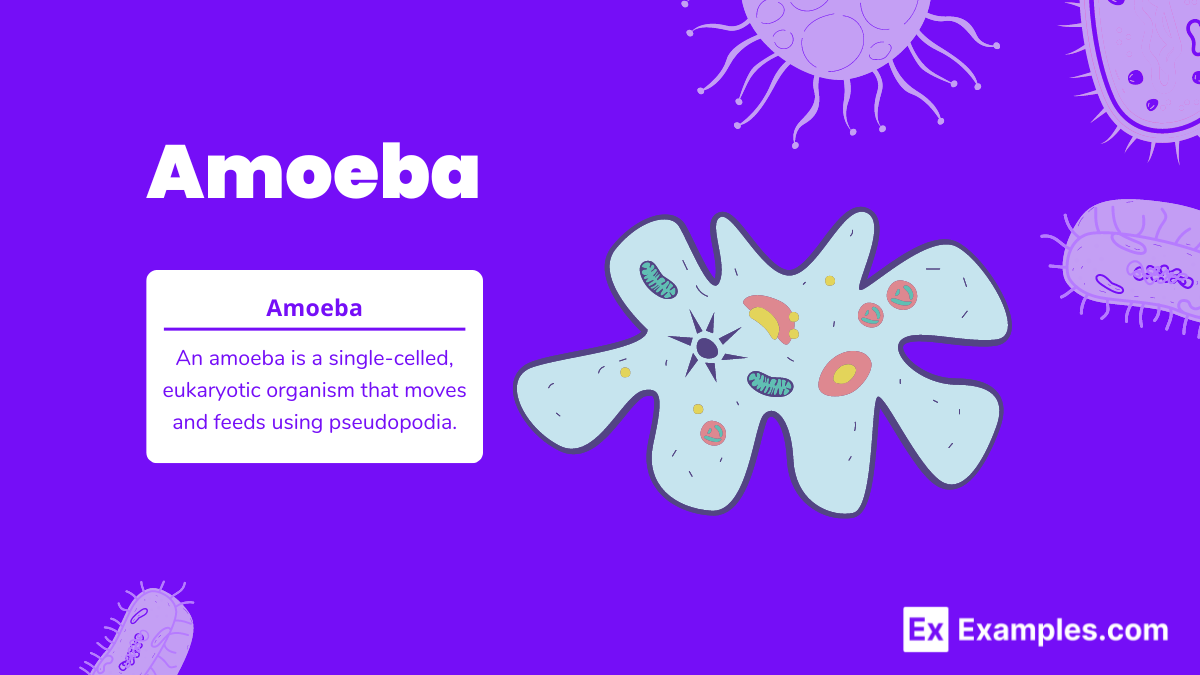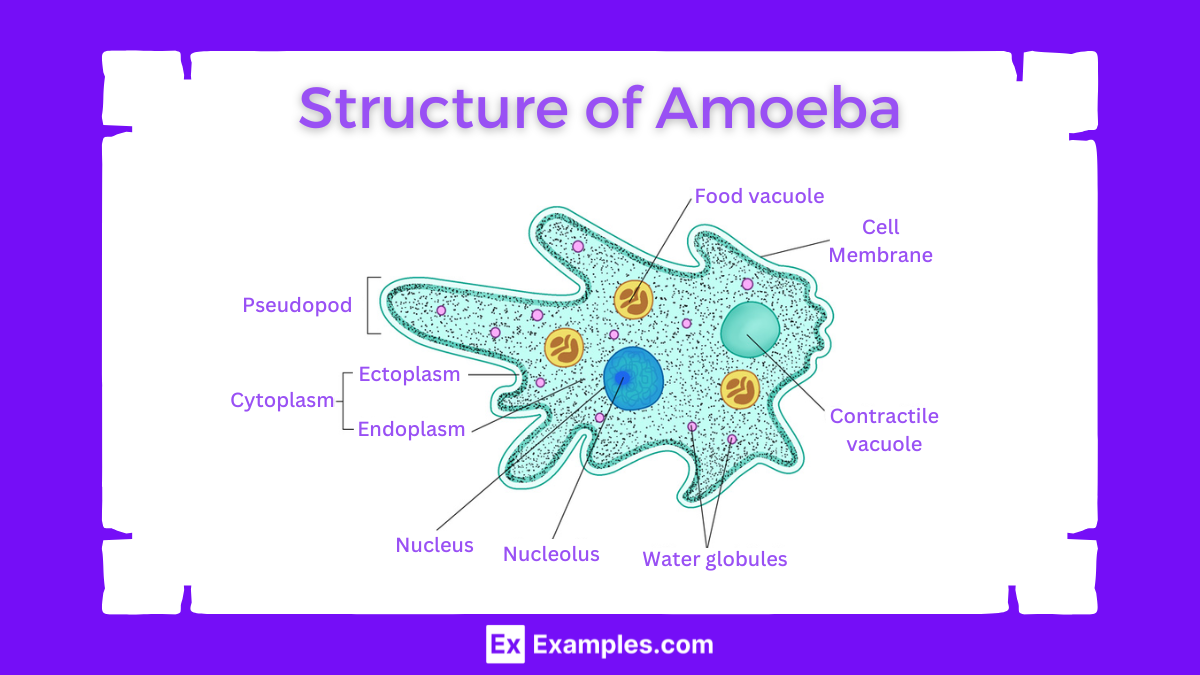What is the primary method by which an amoeba moves?
Cilia
Flagella
Pseudopodia
Contractile vacuole


Amoebas are fascinating single-celled organisms that thrive in diverse environments. They belong to the kingdom Protista and exhibit remarkable adaptability. These microscopic entities move and feed using pseudopodia, which are temporary projections of their cytoplasm. Amoebas play crucial roles in ecosystems as both predators and prey. They contribute to nutrient cycling and maintain the balance of microbial communities. Studying amoebas offers insights into basic biological processes and evolutionary history, making them an essential subject in the field of microbiology.
An amoeba is a type of single-celled organism belonging to the kingdom Protista. Amoebas are characterized by their ability to change shape due to their flexible cell membrane and the presence of pseudopodia, which are temporary projections of the cell. These pseudopodia allow the amoeba to move and capture food through a process called phagocytosis.

Amoebas possess a simple yet highly efficient structure that allows them to thrive in various environments. Here’s an explanation of the key components of an amoeba’s structure:
Kingdom: Protista
Amoebas are traditionally classified under the Kingdom Protista. They are distinct from plants, animals, and fungi, yet they share the common characteristic of being eukaryotic organisms, meaning they possess a true nucleus.
Domain: Eukaryota
As eukaryotes, amoebas have a defined nucleus encased within a membrane. This differentiates them from prokaryotes, which lack a true nucleus.
Phylum: Amoebozoa
Within the Protista kingdom, amoebas are placed in the phylum Amoebozoa. This phylum includes organisms that move and feed using pseudopodia, which are temporary projections of their cytoplasm.
Class: Lobosa
Amoebas typically belong to the class Lobosa, characterized by their lobose pseudopodia. These are blunt and finger-like extensions that assist in movement and ingestion of food.
Order: Various (e.g., Tubulinida, Arcellinida)
Amoebas can be further divided into different orders based on their morphology and genetic characteristics. Common orders include Tubulinida, which consists of free-living amoebas, and Arcellinida, which comprises testate (shelled) amoebas.
Genus and Species: Various
There are numerous genera and species of amoebas, each with unique features. Some well-known genera include:
Special Note on Naegleria fowleri: Though not a true amoeba, Naegleria fowleri is an amoeboid organism that can cause severe infections in humans. It enters the body through the nose and travels to the brain, where it feeds on neurons, leading to brain tissue destruction. The infection it causes, known as primary amebic meningoencephalitis (PAM), has a high fatality rate of approximately 97%.
Amoebas perform several crucial functions that allow them to survive and thrive in various environments. Here are the main functions of amoebas:
Amoebas primarily reproduce asexually through a process called binary fission. This method of reproduction is relatively simple and involves the following steps
Amoebas are simple, single-celled organisms that belong to the kingdom Protista. They are characterized by their irregular shape, which is constantly changing. This shape is due to the absence of a rigid cell wall, allowing the amoeba to form extensions called pseudopodia (false feet). Pseudopodia are temporary projections of the cell membrane and cytoplasm that the amoeba uses for movement and capturing food.
The primary method of movement in amoebas is known as amoeboid movement. This type of movement is facilitated by the formation of pseudopodia. Here’s how it works:
Amoebas are heterotrophic organisms, meaning they obtain their food by consuming other organisms. Their feeding process is known as phagocytosis. Here’s how amoebas feed:
Amoebas vary in size depending on the species. Their size can range from as small as a few micrometers to as large as several millimeters. Here is a general overview of the size range of amoebas:
The origin of amoebas traces back to the early stages of life on Earth, approximately 1.5 to 2 billion years ago. Here is an overview of their origin and evolutionary history:
Amoebas are highly adaptable and can thrive in a variety of environments. Their habitats include:
Amebae are single-celled organisms that can cause various diseases in humans. Here are some notable diseases caused by ameba:
Causative Agent: Entamoeba histolytica
Transmission: Fecal-oral route, primarily through contaminated food and water.
Symptoms:
Complications: Severe cases can lead to liver abscesses, intestinal perforation, and peritonitis.
Causative Agent: Naegleria fowleri
Transmission: Entry of contaminated water into the nasal passages, often during swimming in warm freshwater bodies.
Symptoms:
Complications: Rapidly progresses to death if not treated promptly. PAM is almost always fatal.
Causative Agents: Acanthamoeba species and Balamuthia mandrillaris
Transmission: Through skin wounds or inhalation of cysts, can occur in immunocompromised individuals.
Symptoms:
Complications: Often fatal without early diagnosis and treatment.
Causative Agent: Acanthamoeba species
Transmission: Contact lens use, exposure to contaminated water.
Symptoms:
Complications: Can lead to blindness if not treated effectively.
While some amoebas are known for causing diseases, many others play beneficial roles in the ecosystem and can indirectly or directly benefit humans. Here are some ways amoebas are beneficial
An amoeba is a single-celled, eukaryotic organism that moves and feeds using pseudopodia.
Amoebas inhabit freshwater, marine environments, soil, and inside host organisms.
Amoebas move using pseudopodia, temporary cytoplasmic projections.
Amoebas feed on bacteria, algae, and organic matter through phagocytosis.
Amoebas reproduce asexually through binary fission, creating genetically identical daughter cells.
No, most amoebas are harmless, but some, like Entamoeba histolytica, can cause diseases.
Binary fission is a form of asexual reproduction where a single cell divides into two identical cells.
Amoebas can cause diseases like amoebic dysentery and primary amebic meningoencephalitis.
Amoebas play crucial roles in nutrient cycling, soil health, and scientific research.
Pseudopodia are temporary, finger-like projections used by amoebas for movement and feeding.
Text prompt
Add Tone
10 Examples of Public speaking
20 Examples of Gas lighting
What is the primary method by which an amoeba moves?
Cilia
Flagella
Pseudopodia
Contractile vacuole
How does an amoeba obtain its food?
Photosynthesis
Absorption through its membrane
Engulfing food particles through phagocytosis
Diffusion
What structure helps an amoeba maintain water balance?
Pseudopodia
Contractile vacuole
Mitochondria
Nucleus
Which of the following best describes the reproduction method in amoeba?
Binary fission
Budding
Sexual reproduction
Conjugation
In which environment is an amoeba most commonly found?
Hot deserts
Freshwater bodies
Arctic regions
Dry soil
Which organelle in the amoeba is responsible for digestion of food particles?
Lysosomes
Mitochondria
Golgi bodies
Ribosomes
What happens when an amoeba encounters unfavorable environmental conditions?
It migrates to a new location
It dies immediately
It forms a cyst
It reproduces rapidly
What is the primary function of the nucleus in an amoeba?
Controlling water balance
Carrying out digestion
Regulating metabolic activities
Releasing waste products
How does an amoeba respire?
By using gills
By diffusion through the cell membrane
By lungs
By pseudopodia
What is the outer covering of an amoeba known as?
Cell wall
Pellicle
Plasma membrane
Cytoplasm
Before you leave, take our quick quiz to enhance your learning!

